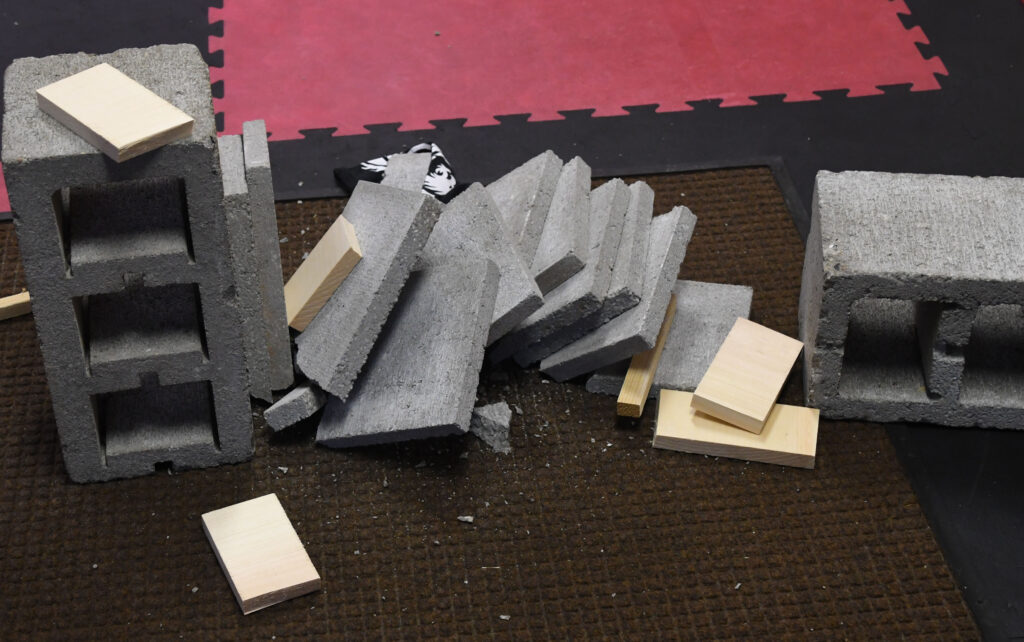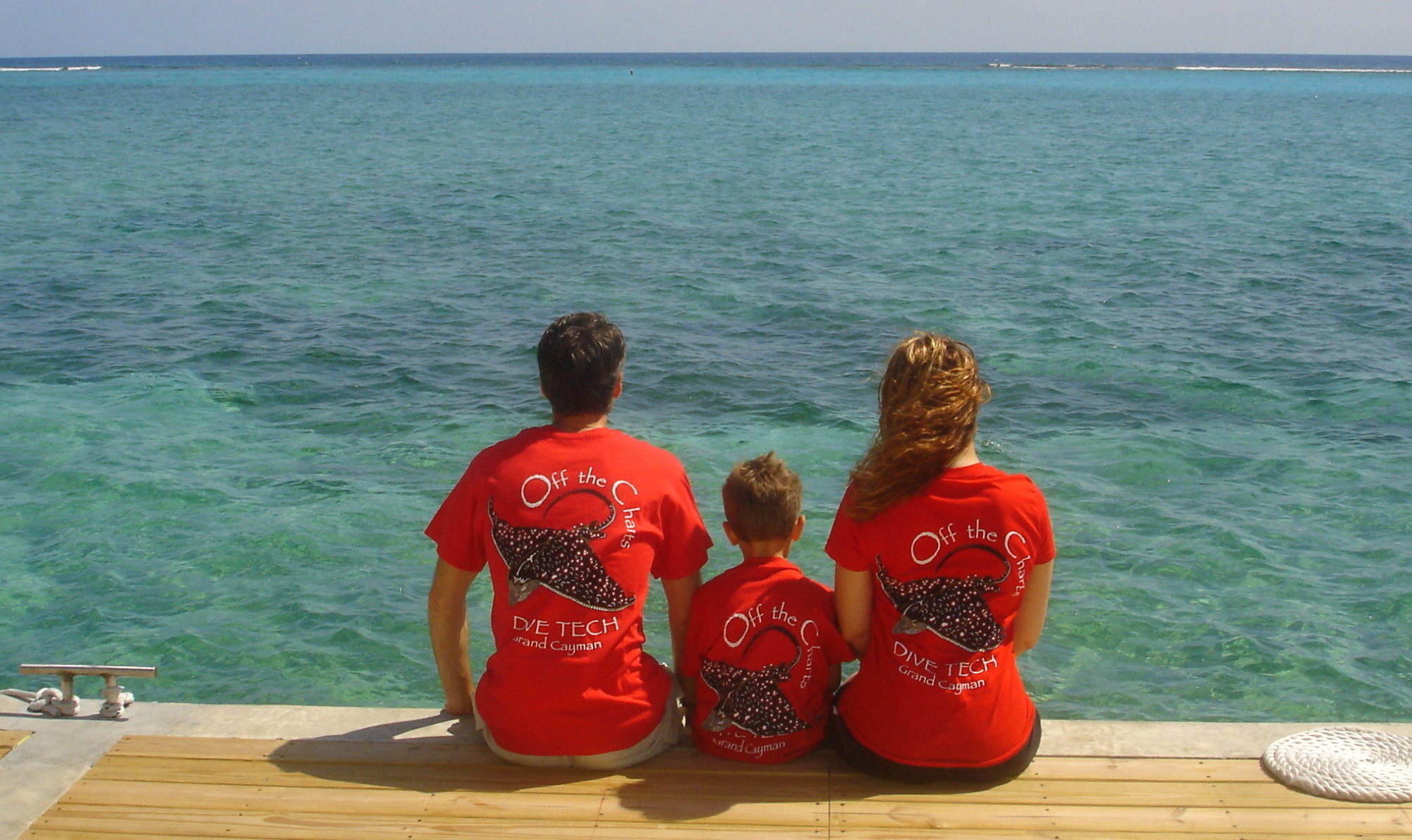Last week, two days before Thanksgiving, I tested for my second degree black belt. The test lasted two hours and was as physically intense as I expected it to be. What I didn’t expect was how mentally taxing it would end up being and what I would discover in myself at the end.
The final part of the exam was the so-called “power test.” The purpose of the power test is to determine if the student has mastered certain techniques well enough to execute them with power and precision, as demonstrated by breaking pine boards and, in the case of dan tests (i.e. black belt tests), cement pavers as well. The techniques to be demonstrated vary with belt rank and sometimes the student is allowed to select from several options. In my case, I was to break a single ¾ inch thick suspended board with a rear inward palm strike, two stacked, ¾ inch thick boards with a spinning reverse swing kick, and six cement pavers with a downward kick. In that order. In this post I want to focus on the cement break.
The power test comes at the end of the exam when one is already exhausted physically and perhaps more importantly, mentally. For a good, clean break, one needs to focus, bringing together all the little details of muscle control, joint alignment, kinetic chain linkage, and targeting. Many times a student will make several attempts before finally breaking their board(s). In the case of cement breaks, often they will break only the top one or two pavers on the first strike. Given the fatigue by this point in a dan test, this is frequently a situation where one doesn’t rise to the occasion, but insteads falls to the level of one’s training.
I was allowed to choose the number of pavers and was still deciding up until it was time to stack them. In the end, I really don’t know why I settled on six. I think part of it was that Sebastian had broken six at his ee dan test years ago. I wanted a challenge, but I also know better than to expect to try everything Sebastian does (see Tree Skiing). What I know with absolute certainty is that I was more intimidated by the thought of breaking six cement pavers than I’d ever been with any previous break.
In the style I practice, a rear-leg downward kick starts with a pivot on the balls of one’s feet. So if I’m in a left-front stance, that is to say, left foot forward, right foot back, and the two about a shoulder’s width apart, I pivot on the balls of my feet to the left. I then chamber my rear leg by drawing my knee up as high as I can, keeping the leg bent and relatively close to my body. From here I extend my leg at the knee, throwing the leg up as high as I can and simultaneously “reversing the pivot” until I am square to my target in front of me. At the end of the reversal, with my right leg in the air in front of me, I look a bit as though I’ve just kicked a football. To finish the kick, I keep my leg straight and pull it down as hard as I can, striking with the heel at a target which, if one is young, flexible and skilled, is no higher than one’s sternum.
We almost never practice downward kicks with a target; doing that safely requires a special pad which is a bit awkward to hold, and so we’re left imagining a proper target. While it is always true that kicking the air is different from kicking and making contact with a target, this is especially true of the downward kick. There’s no recoil to speak of with this kick and the instruction is to practice it without hitting the ground too hard for fear of injuring one’s knee. Practicing this way comes with a couple of very real pitfalls. The first is creating a habit of slapping the ground with one’s foot, rather than striking with one’s heel. The second is creating the habit of simply letting one’s foot fall to the ground, rather than using one’s glutes and hamstrings to drive the heel down. In my practicing of this kick in the many months leading up to this test, I made a point of both being aware of the heel as the striking surface and driving it into the target.
After deciding on the number of blocks, I was so preoccupied with doubts about the break that I was barely aware of Sebastian and Garret constructing my target. They stood two cinder blocks on end and bridged a cement paver across them. Then they carefully placed a half-inch thick piece of wood at each end and placed another paver on top of them. They repeated the placing of spacers and pavers four more times, precisely aligning each new level, until all six were stacked.
As I slowly approached the tower, I became aware of how tall it was. Remember that part about only ever imagining a target while practicing this kick? While in reality it probably only stood as tall as mid-thigh, at that moment this target seemed as tall as my chest.
Sebastian stood up from constructing the cement tower, took one look at me and immediately recognized my hesitation. He began giving me all sorts of encouragement and advice. “It’s all about speed. Kick through the target. Your kicks are really strong, you can do this.” His confidence in me was as sincere as it gets, and yet I’m sure that I’ve never been less convinced.
A tall target had me seriously doubting my ability to generate sufficient kicking power and, being the engineer that I am, I anxiously started analyzing the physics of the situation, talking myself through the problem.
“I definitely need to be several inches taller so that when my heel makes contact I have something close to sufficient speed. That means that I should be plantar flexing (getting up onto the ball of my posted foot) as much as humanly possible. And when my heel strikes, I want it to be moving straight down, wasting not even one tiny bit of force by striking at an angle. And if I can, I want to leverage gravity by relaxing the knee of the posted leg so as to be falling just a bit as I make contact. And, man, you had better hit that dead center.”
And then, the physics requirements being well understood, that internal technical discussion gave way to a chorus of voices from those sister tribes of Doubt and Fear.
“There’s no way you can break all of those pavers,” whispered someone from tribe Doubt.
“You really should have agreed to a shorter stack,” stated another, louder and very matter-of-factly.
And then someone from tribe Fear really started running his mouth. “You are really going to hurt yourself on this. Your heel might be padded up, but you’ll likely bruise it anyways. And what about your knee? How long will it take you to heal from a knee hyper-extension injury at your age? Is this really worth it?”
Doing my very best to ignore the noisy commentary from the sister tribes, I executed a slow practice kick. Pivot, chamber, throw the leg up while plantar flexing, pivot again to square up my hips, and pull down the kicking leg while dropping just a bit on my posted leg.
That didn’t feel quite right.
I adjusted my distance from the tower and practiced again. Pivot, chamber, plantar flex, leg up, pivot, leg down. That felt better but the targeting wasn’t quite right. And then a third time. Pivot, chamber, leg up, pivot, drop and leg down. Good.
The distance felt right. The motion felt right. But the fear, mostly of injury, still loomed large in my mind.
And then it happened; I decided that I didn’t care if I got injured. I decided that I was going to completely destroy that cement tower before me regardless of the consequences. It was as if I had found and flipped a heretofore hidden switch that activated an extreme commitment to the objective. This commitment differed from the hundreds of “one more step” commitments that I knew well from the last mile of hard 5 or 10K races. In this case, imagine instead distilling and concentrating the determination summoned for each of those “one more step” commitments into one single, brief moment to accomplish the impossible.
To my surprise, the noisy tribes disappeared and in their place was a deep stillness, a stillness bordering on emptiness. I’m tempted to say it was a moment of calmness but that wouldn’t be quite right because calmness implies an emotion. This particular moment was strangely free of emotion.
The room was completely silent. Or at least, I remember nothing but silence.
And the next thing I remember was hearing the crash of grinding stone and my heel landing on the ground among broken bits of still shifting cement pavers.
And I remember turning to Sebastian and seeing the tears in his eyes. He had understood before I did. The test was over and I had passed.
One of my university professors once told me that one hallmark of a good exam is that the candidate doesn’t simply demonstrate, but also learns something in the process. By that measure, my exam was very good. While I might have been able to perform the break without the physical and mental pressures of the previous two hours, I’m not sure that I would have found that “switch.” Often we must be subjected to extreme conditions in order to discover our more extreme capabilities. For many, modern life is very comfortable and this example perhaps makes a case for periodically setting really demanding, physical challenges for oneself as a means of self-discovery and growth. I do wonder about my ability to find my new switch “on demand.” But for right now, it’s enough for me to know that it exists.

